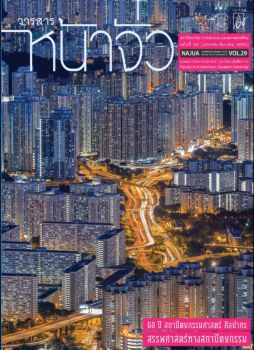แนวทางการลดอุณหภูมิอากาศของสภาพแวดล้อมขนาดเล็ก จากอิทธิพลองค์ประกอบระนาบพื้น
Keywords:
สภาพแวดล้อม, ระนาบพื้น, อุณหภูมิอากาศขนาดเล็ก, Environment, Ground cover, Micro-climate TemperatureAbstract
อุณหภูมิของอากาศที่เพิ่มขึ้นจากอิทธิพลความร้อนของสภาพแวดล้อม เกิดจากการถ่ายเท ความร้อนของผิววัสดุโดยรอบอาคารที่ได้รับอิทธิพลความร้อนจากดวงอาทิตย์ ทำให้อุณหภูมิผิววัสดุสูง กว่าอุณหภูมิอากาศ ทั้งนี้ ขึ้นอยู่กับปริมาณรังสีดวงอาทิตย์ (Solar radiation) องค์ประกอบระนาบ พื้น มีอิทธิพลต่อการเปลี่ยนแปลงอุณหภูมิอากาศมากที่สุด จากการศึกษาพบว่า คุณสมบัติความจุ ความร้อน (Heat capacity) ของวัสดุพื้นมีอิทธิพลต่อการเปลี่ยนแปลงอุณหภูมิผิว ส่งผลต่อการถ่ายเทความร้อนสู่สภาพแวดล้อม วัสดุพื้นที่มีค่าการถ่ายเทความร้อนมากที่สุด ได้แก่ คอนกรีต ดิน หญ้า และ นํ้า ส่งผลต่อการเปลี่ยนแปลงอุณหภูมิอากาศ +2.1, +1.2, -0.5, และ -1.7 องศาเซลเซียสตามลำดับ (ค่าปริมาณรังสีดวงอาทิตย์สูงสุด 240 btu/ft2/h) วัสดุที่มีค่าความจุความร้อนมาก เช่น นํ้า (Heat capacity=1 cal/g.oC) จะมีการเปลี่ยนแปลงอุณหภูมิผิวน้อย (6.1 oC) ส่งผลต่อการเปลี่ยนแปลงของ อุณหภูมิอากาศน้อย (-1.7 = oC) และวัสดุที่มีค่าความจุความร้อนน้อย เช่น คอนกรีต (Heat capacity= 0.22 cal/g.oC) จะมีการเปลี่ยนแปลงอุณหภูมิผิวมาก (24 oC) ส่งต่อการเพิ่มขึ้นของอุณหภูมิ อากาศมาก (max=+2.1 oC) อย่างไรก็ดี อิทธิพลของร่มเงาต้นไม้สามารถช่วยลดปริมาณความร้อน จากสกัดกั้นการตกกระทบของรังสีดวงอาทิตย์ได้มากกว่าร้อยละ 83
แนวทางการออกแบบสภาพแวดล้อมภายนอกอาคาร (1) สร้างพื้นที่ร่มเงาจากต้นไม้ใหญ่ เพื่อสกัดกั้นปริมาณรังสีจากดวงอาทิตย์ที่ตกกระทบวัสดุดาดแข็ง (2) พื้นที่โดนแดด กำหนดให้เป็น วัสดุดาดอ่อน จำพวกพื้นหญ้าและแหล่งนํ้า ที่มีค่า Heat capacity มาก ลักษณะดังกล่าวจะสามารถ ลดอิทธิพลการเกิดความร้อนจากสภาพแวดล้อมโดยรอบอาคารที่ส่งผลต่อการเพิ่มขึ้นของอุณหภูมิ อากาศได้
Guidelines for Reducing Air Temperature Using Effects of Ground Cover
Punravee Kongboontiam, Ph.D.
Lecturer, Faculty of Architecture and Environmental Design Mae Jo University
Wuttigarn Puraprom
Lecturer, Faculty of Architecture and Environmental Design Mae Jo University
In Thailand, the increase in air temperature that is caused by heat transfer from the surroundings to a building is affected by site elements that have been exposed to solar radiation, which causes surface temperature to be higher than airtemperature. Ground cover have the greatest effect on change in air temperature. The study found that heat capacity of the ground elements has an effect on surface temperature and heat transfer to the environment. Ground cover that have the highest heat transfer rates are concrete, soil, grass and water. They change air temperature by +2.1, +1.2, -0.5, and -1.7 oC, respectively (with maximum solar radiation of 240 btu/ft2/h). Materials that have high heat capacity like water (Heat capacity = 1 cal/g.oC) will have relatively small change in surface temperature (6.1oC) and small change in air temperature (-1.7oC). Materials with low heat capacity like concrete (Heat capacity = 0.22 cal/g.oC) will have high change in surface temperature (24oC) and high change in air temperature (max = +2.1oC). The shading of trees can block heat from solar radiation as much as 83 percent.
The design guidelines for outdoor are ; 1) create shades using large trees to prevent solar radiation from touching hardscape, 2) areas touched by sunlight should use softscape that have high heat capacity such as water and grass. Employing these two methods will reduce the heat effect of ground elements on air temperature.





